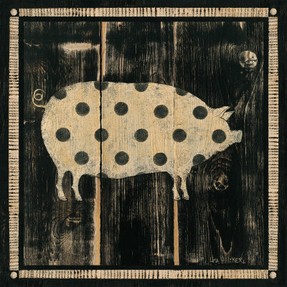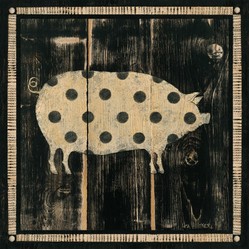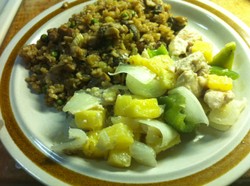For many of us, pork crackling is the highlight of a roast pork dinner, but not all of us really know how to make pork crackling so it's perfectly crispy every time. This article guides you through all the steps to making roast pork with crackling. There's no single recipe, but there are some common methods and techniques. Provided you start out with a good joint of pork, take time to prepare it and cook it correctly, there should be no reason why you can’t make perfect pork crackling yourself.

How to Make Pork Crackling
Step by step instructions on how to make pork crackling that comes out of the oven perfectly crispy every time you roast pork.
Cooking Pork Crackling
... after some bad earlier experiences
 Pork crackling can so often be a disappointment, sometimes downright dangerous to our dental health. A chewy, leather-like consistency is not what we want, but that’s what we sometimes end up with.
Pork crackling can so often be a disappointment, sometimes downright dangerous to our dental health. A chewy, leather-like consistency is not what we want, but that’s what we sometimes end up with.
When this happened to me, I always used to blame it on the quality of the raw ingredients but I was wrong. I just wasn’t going about things in the right way. A good layer of fat under the skin is essential, but the rind also has to be nice and dry prior to putting the pork joint in the oven.
Follow the simple stages outlined below, like I did, and you'll learn how to make pork crackling like an expert.
If you're looking for some great roast pork recipes, try this page I wrote on Squidoo. Pork belly is probably the ultimate cut for pork crackling, and it's an affordable cut too - Pork Belly Recipes.
Image credit - Polka Pig I by Lisa Hilliker - Buy this at Allposters.com
Gordon Ramsay's Ultimate Cookery Course
This is the cookery book I found most useful in 2012
 | Gordon Ramsay's Ultimate Cookery Course (International Edition) |
How to Cook Pork Crackling
... in seven easy stages
Stage 1 – Start preparations the night before. You can’t expect great results if you plan on taking your pork joint out of its packaging, rubbing a bit of salt into it and popping it straight in the oven. I’ll explain why in steps 3 and 4.
Stage 2 – Scoring. Everybody knows that the pork rind needs scoring, and often a pork joint will come ready scored. This is so that the heat of the oven can get deep into the skin and layers of fat quickly. You can do it yourself if you’ve got a sharp enough knife. A Stanley (DIY) knife with a clean new blade is ideal. I use a scalpel. These seem almost designed for the job, oddly enough. The cuts should penetrate the skin and go into the fat, but not into the meat as a layer of fat is needed to keep this moist. Scores should be about one finger’s width apart, but don’t use an actual finger to measure it as this can be hazardous.
Stage 3 – Scald the rind. Not every recipe you read will suggest this technique. It’s probably borrowed from Chinese cookery where cuts like pork belly are very popular. Pour boiling water over the skin side of the joint. This will shrink the skin and open up the scores. Excessive moisture will ruin pork crackling, so there then follows a period of drying, or desiccation.
Stage 4 – Desiccation. Wait until it cools off a bit then pat the joint with a clean dish towel to remove any visible water. Some recipes suggest you marinade the joint in spices or even vinegar at this stage, but don’t add salt just yet. Leave the joint to dry overnight. You can do this in a variety of ways. Some say you should hang it with a meat hook but it’s probably easiest to wrap it in a clean dry towel and leave it in the refrigerator. Then, an hour or two before cooking, remove it from the refrigerator and leave it uncovered to dry even more. I’ve read that some people use a fan, or even a hair dryer, to help this along.
Stage 5 – Salting. Before you begin salting, set the oven to pre-heat to the max. I’ll explain why next. Rub salt into the pork rind. I’ll leave it up to you to decide how much salt, but don’t be too ungenerous about it. This isn’t a health food recipe after all. Really rub the salt in. You can be quite aggressive and vigorous, or painstaking and gentle, but get the salt deeply into the score lines and all across the skin. Now the pork is ready for the oven, just so long as it’s reached its maximum temperature.
Stage 6 – Roast. Briefly roast your pork joint at the maximum temperature for the first fifteen or so minutes. This is really important. During this time, the heat only penetrates the outer layers of your joint and that includes the rind. After quarter of an hour, turn down the oven to a low to medium temperature and roast for the required time. Usually this is about two to three hours, but that depends on the size and type of joint.
Stage 7 – Everything else. While the pork is roasting, you can focus your attentions on everything else needed for your pork roast dinner – potatoes, vegetables, apple sauce, egg fried rice etc. When the joint is cooked, don’t forget that you need to take it out and let it rest for ten minutes or so before carving. This is usually the time for making gravy. The pork crackling should be crisp but not hard. Try not to nibble too much of it before you deliver it to the table. Leave a bit for your family or guests to enjoy.
You might also like
Pineapple Stir-Fry Chicken Served With Pork-Fried Rice RecipeTwo easy to follow healthy recipes that are both stir-fried. Fresh pineapple ...
Cooking Your Own Tongue: A Tongue In Cheek Recipe For Cooking ...Cooking your own tongue is the natural way to obtain the best results. Cookin...



 What is a Sustainable Fish?on 11/23/2012
What is a Sustainable Fish?on 11/23/2012
 Red Kites in Britain - a Remarkable Comebackon 09/30/2012
Red Kites in Britain - a Remarkable Comebackon 09/30/2012
 Britain's White-tailed Eagles - Extinction and Recoveryon 09/29/2012
Britain's White-tailed Eagles - Extinction and Recoveryon 09/29/2012
 The Judas Tree - or Love Treeon 09/29/2012
The Judas Tree - or Love Treeon 09/29/2012



Do you have any tips on how to make pork crackling?
Thanks katiem2. What an amazing thing the Atlantic Ocean is? Here in the UK, making pork crackling is a serious matter. There are even places (at least two) on my local market where you can buy a pork roast sub with pork, stuffing, apple sauce and crackling. They're very popular, and rightly so. I'm very glad to have stirred up an interest in pork crackling in the US. Thanks for sharing this with your friends. Tell them not to eat too much of it - it's delicious but not exactly health food. Yes, pork rinds are similar. We call them pork scratchings. It's the same thing. Pork crackling (we just say crackling) is better, served hot with a Sunday roast.
Thanks Angel. My grandmother used to cut the rind off bacon, fry that first to render the fat, add the bacon later, fry that, then fry stale bread in the fat that was left. I think that generation had a different view on fat - waste not, want not. Of course, I'm not advocating we eat more fat. I like your grandmother's recipe though. Sounds like our grandmothers would get along well.
I can't believe there is anyone else who knows about pork crackling! My grandmother used to make pork crackling all the time and then make crackling bread with it. Basically a corn bread cooked in a black iron skillet in the oven with pork crackling in it. I have not even heard of pork crackling since I was a child or since my grandmother passed away over 20 years ago. This does bring back the memories!
How cool this takes me back as I remember hearing my Grandfather talk about making this very thing. The city folk around here love pork rinds while in the same ball park different as i understand. This is a treasure of a recipe, guide and facts on the historical pork crackling I have got to share this as I'm sure many others will experience a flash back in time and want to make them for themselves. :)K
Thanks UnnamedHarald. I grew up in the West Midlands in England. Pork "scratchings" originated from there (I think.) You might call them Pork Rinds. That's like crackling in a packet. Now that IS meat candy. Now they're popular everywhere. You can buy them in the pub and the sweet shop. Home made crackling is the best though.